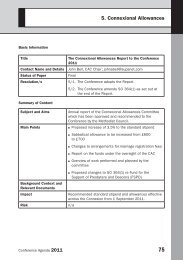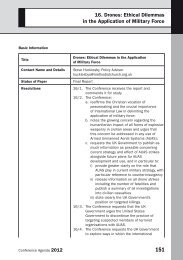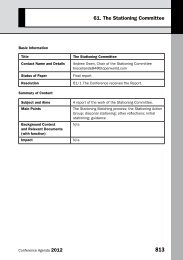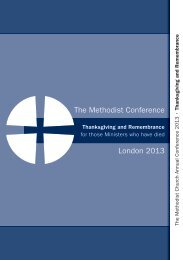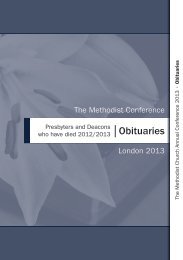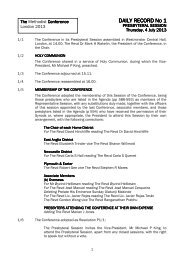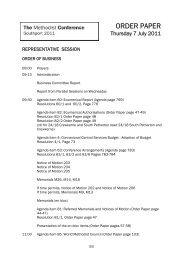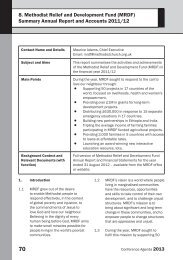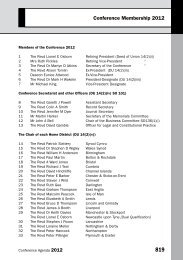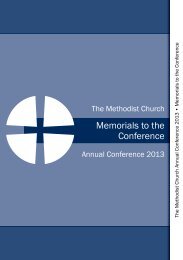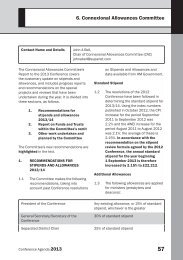Agenda Volume 3 - Methodist Conference
Agenda Volume 3 - Methodist Conference
Agenda Volume 3 - Methodist Conference
Create successful ePaper yourself
Turn your PDF publications into a flip-book with our unique Google optimized e-Paper software.
57. The Fruitful Field Project<br />
for gathering and learning need<br />
to be safe, sustaining, welcoming<br />
– spaces with personality within<br />
which people find room to reflect<br />
and to be inspired. Size, form,<br />
location, accessibility, technological<br />
facilities, acoustics and furniture<br />
are all appropriate and necessary<br />
considerations.<br />
193 The Committee believes there is<br />
much to be gained from taking a<br />
systematic and informed approach<br />
to developments in this area, and<br />
is confident that it will be possible<br />
to identify a number of apt and<br />
excellent spaces for gathering and<br />
learning across the Connexion. This<br />
necessarily involves a redirection<br />
of attention away from sponsoring<br />
a number of institutions, colleges<br />
and centres across the Connexion<br />
towards the development of spaces,<br />
on the understanding that such<br />
spaces will be able to provide the<br />
flexible and appropriately-configured<br />
resource which will complement the<br />
regional teams and which may also<br />
be able to provide a base for other<br />
types of <strong>Methodist</strong> activity in Districts<br />
and regions. There is also strong<br />
potential for future developments<br />
to tie into the discussions of the<br />
<strong>Methodist</strong> Council’s “larger than<br />
Circuit” working party, as it considers<br />
how best to resource other activities<br />
and responsibilities within the lives<br />
of Districts and regions. These<br />
considerations provide the context for<br />
the implementation of this component<br />
of the core recommendation.<br />
Virtual spaces<br />
194 A number of institutions, colleges<br />
and centres already make use of<br />
virtual learning environments. Such<br />
environments enable a range of<br />
learning resources (including articles,<br />
extracts from books, digital copies<br />
of archival material, recordings of<br />
lectures, programme handbooks,<br />
forms and supporting materials) to be<br />
more easily accessible. An increasing<br />
range of software packages and<br />
improved hardware also enable<br />
interaction (through discussion<br />
boards and real time seminars), thus<br />
allowing virtual learning environments<br />
to be spaces of collaborative<br />
learning as well as a means of<br />
distributing information. Rarely if<br />
ever is engagement through a virtual<br />
learning environment the sole means<br />
of delivering programmes, with<br />
institutions, colleges and centres<br />
opting for a blend of virtual and faceto-face<br />
interaction.<br />
195 The Committee therefore<br />
recommends that the Network should<br />
develop a robust, accessible and<br />
excellent virtual space. This will<br />
enable the Network to complement<br />
other types of formation, learning<br />
and development with apt online<br />
resources and interaction. This will<br />
also enable pathways, opportunities,<br />
programmes and resources to be<br />
more accessible, including to those<br />
who, for reasons of distance or other<br />
commitments, find it difficult to gather<br />
together with other learners on a<br />
regular basis or at particular times.<br />
722 <strong>Conference</strong> <strong>Agenda</strong> 2012



